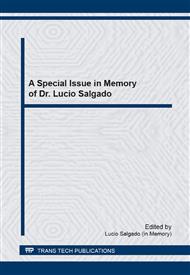[9]
Fig. 1 shows the XRD patterns of Me-TCP powders after calcination at 800oC/1h. It can be observed that β-TCP phase (ICDD 090169) was identified in all powders. This temperature was, thus, suitable for the complete CDHA→β-TCP phase transformation. Fig. 1: XRD pattern of pure and doped Mg- or Zn-TCP powders after calcination at 800oC/1h. The morphology of the TCP powders calcinated at 800oC/1h was evaluated by HR-SEM (Fig. 2). It can be seen the influence of Mg or Zn doping on the distribution and size of the TCP particles. It can be seen that all powders are agglomerated. The particle size distribution in all samples is homogeneous and narrow. It seems that doped powders (Figs. 2b and 2c) shows a decrease in particle size. Moreover, Mg doping (Fig. 2c) seems to be more effective for this behavior. C B A Fig. 2: Scanning electron micrographs of TCP powders after calcination at 800oC/1h: a) TCP, b) Zn-TCP, c) Mg-TCP. Fig. 3 shows the differential thermal analysis results for pure and doped TCP with different ions. It can be seen the influence of Ca-Zn/Mg doping on the phase transformation of TCP based ceramics. At lower temperatures, it is observed endothermic processes related to absorbed and structural water losses, as (1) and (2) respectively indicated. The CDHA → b-TCP phase transformation is characterized by an exotermic-endotermic process (peak 3) related to the CDHA desydroxilation, and, consequently, b-TCP phase formation.
Google Scholar
[8]
The last endotermic peak (peak 4, enlarged shown in Fig 3b) is associated with the β-TCP→α-TCP phase transformation. It can be seen that the Zn-TCP showed lower temperature of this phase transformation as compared with pure or Mg-TCP. Marchi et al.
DOI: 10.1111/j.1744-7402.2009.02384.x
Google Scholar
[1]
M. Jarcho: Clin. Orthop. Rel. Res. Vol. 157 (1981), p.259.
Google Scholar
[2]
M. Vallet- Regi and J.M. González-Calbet: Progress in Solid State Chem. Vol. 32 (2004), p.1.
Google Scholar
[3]
M. Descamps, J.C. Hornez and A. Leriche: J. Euro. Ceram. Soc. Vol. 27 (2007), p.2401.
Google Scholar
[4]
H. -S. Ryu, K.S. Hong, J. -K. Lee, D.J. Kim, J.H. Lee, B. -S. Chang, D. -ho. Lee, C. -K. Leed and S. -S. Chung: Biomaterials Vol. 25 (2004), p.393.
Google Scholar
[5]
M. Matsumoto, K. Sato, K. Yoshida, K. Hashimoto and Y. Toda: Acta Biomaterialia Vol. 5 (2009), p.3157.
Google Scholar
[6]
I. Mayer, F.J.G. Cuisinier, S. Gdalya and I. Popov: J. Inorg. Biochem. Vol. 102 (2008), p.311.
Google Scholar
[7]
M. Yamaguchi, H. Oishi and Y. Suketa: Biochem. Pharmac. Vol. 36 n. 22 (1987), p.4007.
Google Scholar
[8]
J. Marchi, A.C.S. Dantas; P. Greil, J.C. Bressiani, A.H.A. Bressiani, and F.A. Muller: Mater. Res. Bulletin Vol. 42 (2007), p.1040.
DOI: 10.1016/j.materresbull.2006.09.015
Google Scholar
[9]
M. Tamai, M. Nakamura, T. Isshiki, K. Nishio, H. Endoh and A. Nakahira: J. Mater. Sci., Mater. Med. Vol. 14 (2003).
Google Scholar


